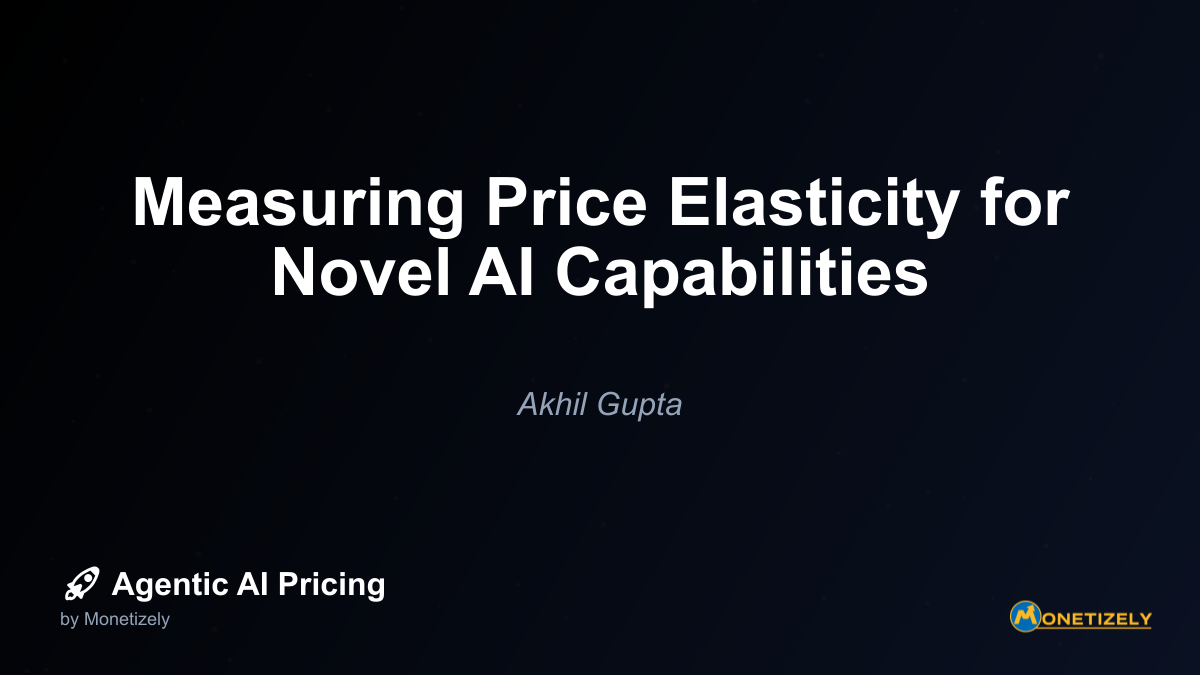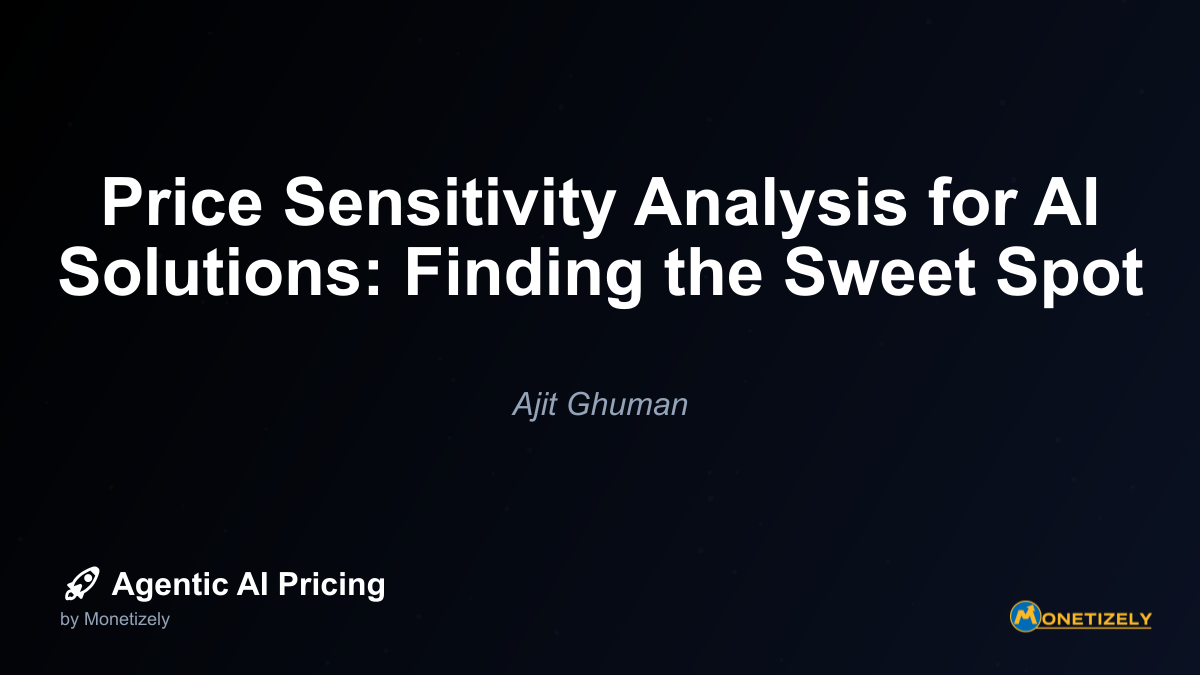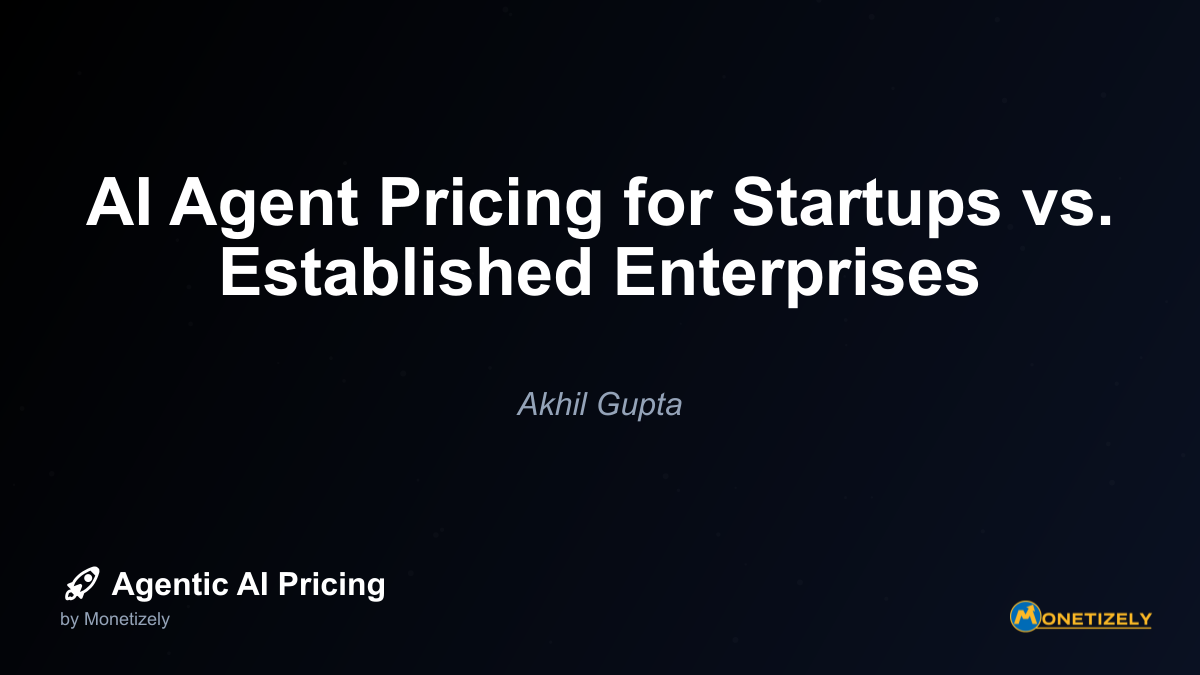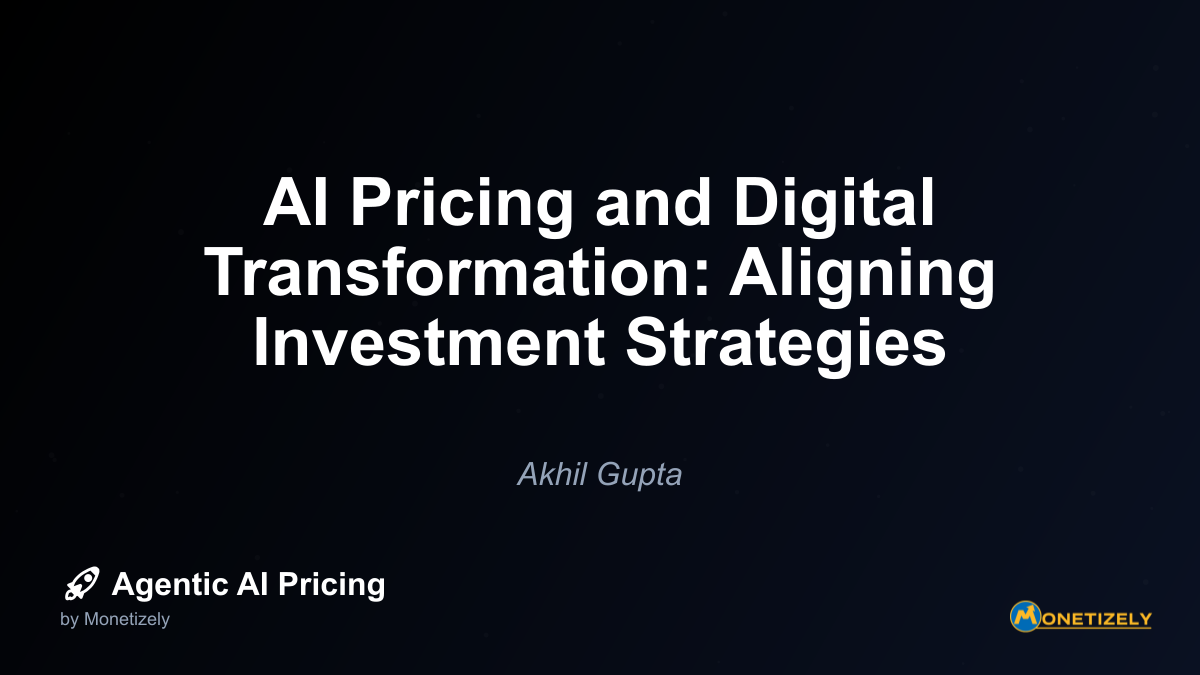· Akhil Gupta · Strategy · 13 min read
Measuring Price Elasticity for Novel AI Capabilities
AI and SaaS Pricing Masterclass
Learn the art of strategic pricing directly from industry experts. Our comprehensive course provides frameworks and methodologies for optimizing your pricing strategy in the evolving AI landscape. Earn a professional certification that can be imported directly to your LinkedIn profile.

In today’s rapidly evolving artificial intelligence landscape, understanding price sensitivity for novel AI capabilities has become a critical strategic imperative. As organizations invest heavily in developing and deploying innovative AI features, the challenge of determining optimal pricing strategies grows increasingly complex. The relationship between price points and market demand for emerging AI capabilities requires sophisticated analysis that goes beyond traditional pricing models.
Price elasticity—the measure of how demand responds to price changes—takes on unique dimensions when applied to cutting-edge AI features. The novelty, complexity, and rapidly evolving nature of these capabilities create distinct challenges for pricing strategists. This comprehensive guide explores the methodologies, challenges, and best practices for measuring price elasticity specifically for novel AI capabilities.
Understanding Price Elasticity in the Context of Novel AI Capabilities
Price elasticity of demand (PED) quantifies how responsive consumer demand is to changes in price. Mathematically expressed as the percentage change in quantity demanded divided by the percentage change in price, this metric provides crucial insights into pricing strategy:
Price Elasticity = % Change in Quantity Demanded / % Change in PriceWhen applied to novel AI capabilities, this fundamental economic concept encounters unique considerations:
Value Perception Complexity: Unlike traditional products with established value benchmarks, novel AI features often represent entirely new capabilities with unclear value propositions.
Rapid Innovation Cycles: The accelerated pace of AI advancement means elasticity measurements must account for continuous feature improvements and market evolution.
Competitive Dynamics: The AI market features both established players and nimble startups, creating a complex competitive landscape that influences price sensitivity.
Multi-dimensional Value: AI capabilities often deliver value across multiple dimensions (efficiency, quality, novelty), complicating the relationship between price and perceived value.
The Unique Challenges of Measuring AI Price Elasticity
Measuring price elasticity for novel AI capabilities presents several distinct challenges that traditional pricing methodologies struggle to address effectively.
Data Limitations and Quality Issues
Novel AI capabilities often lack extensive historical data, creating significant challenges for traditional elasticity models:
- Limited Historical Data: New AI features may have minimal or no sales history, making traditional time-series analysis difficult.
- Multimodal Feature Complexity: AI capabilities involve complex, multimodal features that are difficult to quantify through conventional tabular data alone. Capturing subtle demand drivers requires advanced AI-generated embeddings that enhance predictive accuracy.
- Data Sparsity: Sparse and evolving data on skills or product attributes can constrain measurement because typical datasets may lack resolution into specifics needed to distinguish new AI features or usage effects.
- Quality Concerns: Available data may suffer from sampling biases, inconsistent collection methodologies, or insufficient granularity.
According to recent research from arXiv (2025), traditional pricing analysis methods that rely on aggregated or simplistic historical data fail to segment customers or capture localized demand fluctuations effectively. AI solutions improve granularity but require extensive, high-quality data inputs from diverse sources like competitor prices and market conditions.
Temporal Effects and Market Evolution
The dynamic nature of AI markets introduces significant temporal challenges:
- Diffusion Lags: AI-driven innovations often experience diffusion lags, meaning their economic impact unfolds slowly as complementary investments, skill adoption, and organizational changes take time. This leads to delayed and noisy signals in price elasticity.
- Rapidly Changing Value Perceptions: As users become more familiar with AI capabilities, their value perception and willingness to pay evolve, creating moving targets for elasticity measurements.
- Market Maturation Effects: Early adopters typically exhibit different price sensitivity compared to mainstream users who enter the market later.
- Competitive Landscape Shifts: Rapid entry of new competitors or substitute technologies can dramatically alter elasticity profiles over short timeframes.
Research indicates that dynamic models incorporating lagged price and quantity data, along with evolving product attributes and external market factors, are necessary to estimate realistic and heterogeneous elasticity values instead of static batch regressions that underestimate sensitivity.
Feature Bundling Complications
AI capabilities rarely exist in isolation, creating significant bundling challenges:
- Interdependent Features: AI capabilities commonly come bundled with multiple features or integrated into larger solutions, making it difficult to isolate the price response to any individual novel AI component.
- Value Attribution Difficulties: Users may value the entire solution without clearly distinguishing the contribution of specific AI features.
- Cross-Subsidization Effects: Organizations may strategically price certain AI features to drive adoption of complementary offerings.
- Package Evolution: Product bundles frequently change as new features are added, complicating longitudinal elasticity analysis.
Bundling can obscure price-demand relationships because customers react to combined value propositions rather than single features, requiring models that can explicitly capture interaction effects and heterogeneity across product versions and customer segments.
Methodologies for Measuring Price Elasticity of Novel AI Capabilities
Despite these challenges, several methodologies have emerged as effective approaches for measuring price elasticity in the context of novel AI capabilities.
Experimental Design Approaches
Controlled experiments offer powerful insights into price elasticity for novel AI features:
A/B Testing for Price Sensitivity
A/B testing involves presenting different price points to comparable segments and measuring the resulting demand differences:
- Randomized Price Assignment: Randomly assign users or markets to different price points for the same AI capability.
- Controlled Variables: Maintain consistent marketing, feature sets, and other variables across test groups.
- Statistical Analysis: Measure conversion rates, purchase volume, and revenue across price points to calculate elasticity.
- Segment-Specific Insights: Analyze results across customer segments to identify varying elasticity profiles.
This approach delivers real-world behavioral data but requires sufficient traffic volume and careful experimental design to yield statistically significant results.
Staged Market Rollouts
For enterprise AI capabilities or markets with limited users:
- Geographic Sequencing: Introduce the AI capability at different price points across comparable geographic markets.
- Time-Staggered Analysis: Compare adoption rates and demand volumes while controlling for market-specific factors.
- Natural Experiment Leverage: Use unavoidable pricing variations (e.g., currency fluctuations, localization requirements) as natural experiments.
This methodology works particularly well for enterprise AI capabilities where individual A/B testing may not be feasible due to market visibility concerns.
Survey-Based Methodologies
Survey techniques provide valuable insights when direct market testing is impractical:
Van Westendorp Price Sensitivity Meter
This established methodology asks respondents four key questions about price perceptions:
- Too Expensive: At what price would the AI capability be too expensive to consider?
- Expensive but Considerable: At what price would the capability start to seem expensive, but still worth considering?
- Good Value: At what price would the capability represent a good value?
- Too Cheap/Quality Concerns: At what price would the capability seem so inexpensive that you would question its quality?
Analysis of these responses identifies the acceptable price range and optimal price points. For novel AI capabilities, this approach helps establish initial pricing boundaries before more sophisticated analysis.
Conjoint Analysis for Feature Valuation
Conjoint analysis determines how different attributes, including price, influence purchase decisions:
- Feature-Price Combinations: Present respondents with various combinations of AI features and price points.
- Preference Ranking: Ask respondents to rank or rate their preferences across these combinations.
- Statistical Modeling: Extract the implicit value placed on each feature and the sensitivity to price changes.
- Elasticity Calculation: Derive price elasticity from the relationship between feature utility and price.
This methodology is particularly valuable for understanding how novel AI capabilities are valued relative to other features and how elasticity varies across feature bundles.
According to a 2025 study from Conjointly, variants of this approach include Brand-Specific Conjoint, Brand-Price Trade-Off (BPTO), and Generic Conjoint, each with trade-offs in flexibility and price elasticity calculation reliability.
Advanced Analytics and AI-Driven Approaches
Modern computational techniques offer powerful tools for elasticity measurement:
Machine Learning for Elasticity Modeling
Machine learning models can identify complex relationships between price, features, and demand:
- Random Forests: Excellent for short-term elasticity estimation with 12+ months of data.
- Gradient Boosting: Ideal for capturing seasonal trends and patterns with 18+ months of transaction history.
- Neural Networks: Powerful for long-term price optimization with 24+ months of detailed data.
- Optimal Decision Trees: Provide interpretable elasticity insights when transparency is crucial.
These models analyze price-demand relationships while considering multiple factors such as promotion, seasonality, and competitor actions for dynamic price optimization.
AI-Generated Multimodal Embeddings
Advanced AI techniques can enhance elasticity measurement for novel capabilities:
- Feature Representation: AI-generated embeddings encode complex product features (images, descriptions, brand signals) to enhance demand prediction.
- Latent Factor Identification: Identify hidden factors influencing price sensitivity that may not be explicitly captured in structured data.
- Cross-Modal Analysis: Integrate insights across text, visual, and interactive dimensions of AI capabilities.
This approach is particularly valuable for novel AI capabilities where traditional feature categorization may be insufficient to capture the full value proposition.
Case Studies: Price Elasticity Measurement in Practice
Examining how major AI companies approach price elasticity measurement provides valuable insights into effective methodologies and strategies.
OpenAI’s Multi-Tiered Approach
OpenAI employs a sophisticated multi-tiered pricing model combining free access, pay-as-you-go based on tokens (units of text processed), and subscription plans such as ChatGPT Plus at $20/month. This approach aims to balance broad accessibility with covering high R&D and computational costs.
While OpenAI hasn’t publicly detailed extensive elasticity analyses, its pricing shows an implicit recognition that demand varies across user segments—free tiers encourage experimentation, while subscriptions cater to higher-use customers. The cost per query strongly influences consumer usage, indicating a sensitivity that informs pricing tiers.
A key challenge for OpenAI has been the high marginal cost per query (due to GPU and cloud computing expenses), which limits the feasibility of flat-rate pricing. Even ChatGPT Pro at $20/month can become unprofitable if usage is extremely high. The token-based usage model allows OpenAI to link revenue directly to demand, mitigating revenue loss from heavy users.
Microsoft’s Enterprise-Focused Elasticity Strategy
As a major investor and partner of OpenAI, Microsoft incorporates OpenAI’s models into Azure AI offerings priced on usage metrics like compute time or number of tokens processed. Microsoft leverages AI-enhanced analytics tools for pricing strategy optimization internally, improving elasticity understanding to optimize Azure AI pricing.
Microsoft partly focuses on enterprise pricing models and volume discounts to appeal to large customers with more predictable usage. Challenges include managing customer adoption at scales where AI costs decrease but user expectation for value and pricing flexibility increases.
Google’s Machine Learning-Driven Approach
Google applies AI pricing strategies mostly via Google Cloud AI services priced on usage volume and complexity (e.g., compute hours, data processed). Google’s pricing relies on market segmentation and offers both free tiers and enterprise contracts.
Notably, Google uses machine learning-driven price elasticity models internally for decisions on discounting and bundling to optimize revenue and customer lifetime value. This involves scenario simulation and SKU-level elasticity to model demand response. Challenges include competing with lower-cost open-weight AI models entering the market, forcing Google to balance aggressive pricing with maintaining margins.
Anthropic’s Usage-Based Pricing Strategy
Anthropic’s primary pricing is API-usage-based, charging customers per million characters or tokens processed, reflecting a utility-like pricing model aligned with actual resource consumption. This direct usage pricing helps control costs and aligns income with expenses, as Anthropic still maintains gross margins around 50-55%, indicating the persistent high cost of AI operations even with usage-based billing.
Anthropic has avoided low-cost mass consumer plans, focusing on enterprise customers with known usage patterns to reduce unpredictability and better measure elasticity within specific business segments. Challenges include managing the inevitable trade-off between volume and costs, as each AI response requires costly GPU time.
Implementing a Price Elasticity Measurement Program for Novel AI Capabilities
Based on industry best practices and emerging methodologies, organizations can implement a structured approach to measuring price elasticity for novel AI capabilities.
Step 1: Define Objectives and Understand Value Perception
Begin by establishing clear objectives and understanding how customers perceive value:
- Identify Value Drivers: Determine how customers perceive value from your AI offerings, recognizing that value and price sensitivity vary widely by segment and product maturity.
- Establish Measurement Goals: Clearly define the goals of elasticity measurement (e.g., revenue maximization, market penetration, competitive positioning).
- Align Stakeholders: Ensure alignment across product, marketing, sales, and finance teams on the purpose and application of elasticity insights.
Step 2: Comprehensive Data Collection
Gather clean, comprehensive datasets including:
- Sales Transactions: Prices, purchase dates, customer segment identifiers
- Historical Pricing: Regular prices, discounts, promotions
- Market Context: Competitor pricing, seasonality, macroeconomic factors
- Product Characteristics: Feature sets, AI service modalities, usage data
Ideally, collect 12–24+ months of data depending on chosen modeling approaches, though this may be challenging for novel capabilities.
Step 3: Preprocessing and Segmentation
Prepare data for analysis through careful preprocessing and segmentation:
- Data Cleaning: Ensure accuracy and completeness of all datasets.
- Customer Segmentation: Segment customers by behavior, industry, geography, or usage patterns to capture heterogeneous price sensitivity.
- Feature Representation: Incorporate rich product representations using AI-based embeddings to better reflect product-specific elasticity dynamics.
Step 4: Model Selection and Elasticity Estimation
Choose appropriate models based on data availability and time horizons:
| Model | Best For | Data Requirements |
|---|---|---|
| Random Forest | Short-term elasticity | 12+ months sales data |
| Gradient Boosting | Seasonal and trend analysis | 18+ months transaction history |
| Neural Networks | Long-term price optimization | 24+ months detailed data |
| Optimal Decision Trees | Interpretable elasticity | Historical sales, pricing, product characteristics |
For novel AI capabilities with limited historical data, consider combining survey-based methods (Van Westendorp, conjoint analysis) with early sales data and controlled experiments.
Step 5: Interpretability and Validation
Ensure results are interpretable and validated:
- Incorporate Interpretable Models: Use models like optimal decision trees to ensure transparency and foster collaboration across data scientists and domain experts.
- Real-World Validation: Validate elasticity estimates with controlled price experiments or limited market tests.
- Sensitivity Analysis: Test how elasticity estimates change under different assumptions and scenarios.
Step 6: Implementation Strategies
Translate elasticity insights into actionable pricing strategies:
- Dynamic Pricing Integration: Integrate AI elasticity insights into dynamic pricing engines for real-time adjustments.
- Segment-Based Pricing: Tailor pricing by customer segment based on elasticity profiles.
- Feature Bundling Optimization: Use elasticity insights to create optimal feature bundles that maximize revenue.
- Strategic Investment Guidance: Focus R&D on features that command premium prices based on elasticity data.
Step 7: Continuous Monitoring and Iteration
Establish ongoing processes to refine elasticity measurements:
- Regular Model Updates: Update models with new data and retrain to capture evolving market conditions.
- A/B Testing Program: Implement continuous A/B tests to validate and refine elasticity estimates.
- Market Feedback Integration: Incorporate qualitative feedback from sales and customer success teams to contextualize quantitative findings.
Key Metrics and KPIs for Price Elasticity Measurement
To effectively measure and apply price elasticity insights, organizations should track several key metrics and KPIs:
Primary Elasticity Metrics
Price Elasticity of Demand (PED): The fundamental measure calculated as percentage change in quantity demanded divided by percentage change in price. Values greater than 1 indicate elastic demand (price-sensitive), while values less than 1 indicate inelastic demand (less price-sensitive).
Cross-Price Elasticity: Measures how demand for one AI capability changes when the price of another capability or competitive offering changes. Particularly important for understanding feature bundling effects.
Income Elasticity: Captures how demand changes as customer budgets or spending capacity changes, critical for enterprise AI capabilities during budget cycles.
Business Impact Metrics
Revenue Impact: Changes in total revenue following pricing changes indicate how well elasticity estimates translate to financial results.
Margin Improvement: Improvements in gross margins realized through better pricing strategies based on elasticity insights.
Customer Acquisition Cost (CAC) to Lifetime Value (LTV) Ratio: How elasticity-informed pricing affects the economics of customer acquisition and retention.
Sales Volume Changes: Demand fluctuations post-price change, segmented by product and customer type.
Operational Metrics
Model Accuracy and Interpretability: Metrics such as prediction error, confidence intervals, and user trust scores in model explanations.
Adoption Rate of Pricing Recommendations: Percentage of recommended price changes actually implemented by pricing teams.
Response Time for Pricing Decisions: Speed of adjusting prices dynamically based on AI insights.
Segmentation Effectiveness: Ability to identify segments with distinct price sensitivities and tailor prices accordingly.
Technical Challenges and How to Overcome Them
Measuring price elasticity for novel AI capabilities presents several technical challenges that require specific
Co-Founder & COO
Akhil is an Engineering leader with over 16+ years of experience in building, managing and scaling web-scale, high throughput enterprise applications and teams. He has worked with and led technology teams at FabAlley, BuildSupply and Healthians. He is a graduate from Delhi College of Engineering and UC Berkeley certified CTO.
Pricing Strategy Audit
Let our experts analyze your current pricing strategy and identify opportunities for improvement. Our data-driven assessment will help you unlock untapped revenue potential and optimize your AI pricing approach.




